Get ready to explore the snake-filled landscapes of Arizona and Georgia! These states boast a dense population of snakes, with a wide range of species that will leave reptile lovers and scientists fascinated.
Even though they present a major threat to both people and animals, venomous snakes are essential to keeping the ecosystem in balance. Come along on an exciting journey as we contrast these two states to see which has a greater number of deadly snakes. Join us on a thrilling journey as we compare these two states to determine which has a higher concentration of dangerous snakes.
Discover the unique traits of their snake populations, their habitats, and the potential encounters you might have with venomous snakes in each state. By the end, you’ll be equipped with valuable knowledge and safety tips for your next adventure in these intriguing snake territories.
The Snake Population in Arizona
Arizona leads with the highest number of venomous snakes in the US. With 19 out of the country’s 20 most dangerous snake species, it’s the undisputed champion of snakebite risk. If rattlesnakes intrigue you, Arizona has 13 species for your curiosity. Arizona is home to one-third of all rattlesnake species found worldwide.
We might expect to come across these venomous reptiles in the deserts, but remember, it wouldn’t be a surprise if you find them in the least expected places. They are adept at adjusting to various settings. So, a chance encounter with a rattlesnake is not completely improbable.
Venomous snakes can survive with people in Arizona; they’re less irritable and won’t strike unless provoked. This is despite the fact that the state’s snake population is nothing to be taken lightly.

Arizona is home to one-third of all rattlesnake species found worldwide.
©Harris Motion Photo/Shutterstock.com
5 Most Venomous Snakes in Arizona
The most venomous snakes in Arizona come from the many rattlesnake species it homes. Rattlesnakes have characteristic longer fangs and large venom glands, which make their bites deadly. Rattlesnakes are also unpredictable. You should thus give them a wide berth if you encounter them anywhere.
Alongside its diverse array of rattlesnake species, this captivating state is also home to elusive and venomous coral snakes. While coral snakes are generally less aggressive compared to rattlesnakes, their venom packs a potent punch.
In Arizona, be on the lookout for these highly venomous serpents as we unveil the top contenders you need to watch out for.
1. Arizona Coral Snake
Adult coral snakes typically measure between 11 and 24 inches in length. Their scales are smooth, with bands of red and black divided by narrower bands of light yellow or white.
The Arizona coral snake, also known as the Sonoran coral snake, inhabits various habitats, including desert scrublands, semi desert grasslands, rocky canyons, and woodlands. These venomous snakes are generally elusive and nocturnal, thus not easy to spot.
Arizona coral snakes should be handled with care due to their potent venom. Even though their small, fixed fangs make delivering venom to larger animals challenging, they’re still dangerous.
They use their potent venom to immobilize and kill prey. Even though their main diet is other snakes in the vicinity, they also feast on small mammals and other reptiles like lizards.
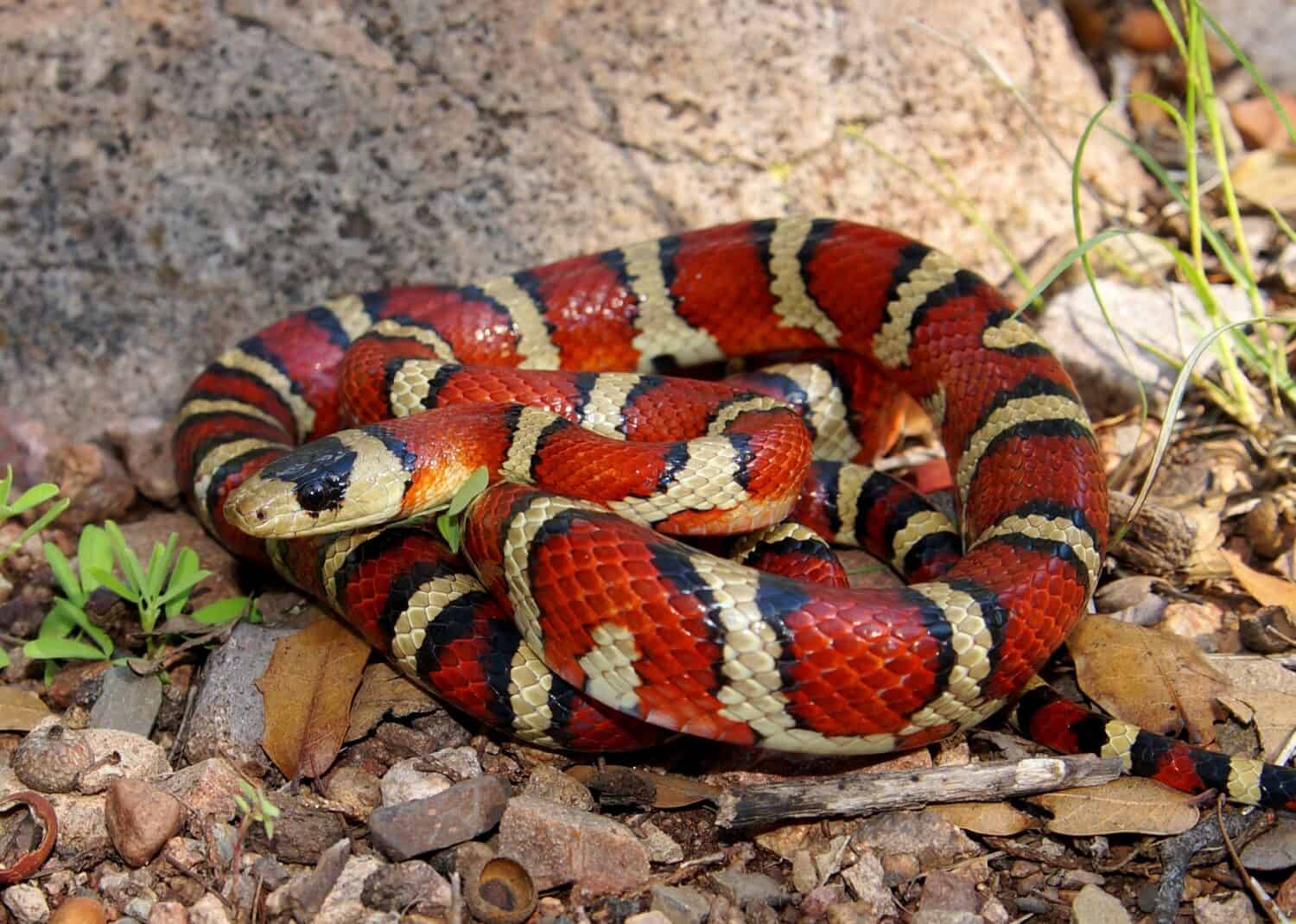
Arizona coral snakes are one of the most venomous snakes in North America. They’re easily identified by their distinctive markings of red, yellow and black stripes.
©Matt Jeppson/Shutterstock.com
2. Western Diamond-backed Rattlesnake
The western diamond-backed rattlesnake is a species of snake with several distinguishing characteristics. It’s a common sighting in Southern Arizona, which presents its best natural habitat. The adults can grow up to 4 feet long and are colored brown, gray, brick red, pinkish, or chalky white.
You can identify a western diamond-backed rattlesnake by its diamond-shaped blotches on its back. White scales outline the blotches making them easier to spot. These blotches take a darker tan than the rest of the body.
Its distinctive coloration aside, the western diamond-backed rattlesnake has a broad, spade-shaped head with a black mask over the eyes. It also has elliptical pupils and pits located between the eyes and nostrils.
The western diamond-backed rattlesnake also has a rattle on its tail. The rattle alternates between black and white-colored bands and is a warning signal to potential predators or threats.
It is possible to encounter this species in deserts, rocky hillsides, or river bottoms. There is also a good chance of spotting one on a rural road during the evenings because of the heat the pavement retains.
The western diamond-backed rattlesnake is feared for its long fangs and large venom glands that deliver enormous venom in a single bite. Untreated bites have a mortality rate of 10-20%; if bitten, you should seek medical help immediately.
Reaching sexual maturity at three years of age, these snakes mate in the spring after emerging from hibernation. Female snakes in Arizona give birth to live babies in litters of 10 to 20 individuals, with high mortality rates. However, the surviving young snakes can live for over 20 years.
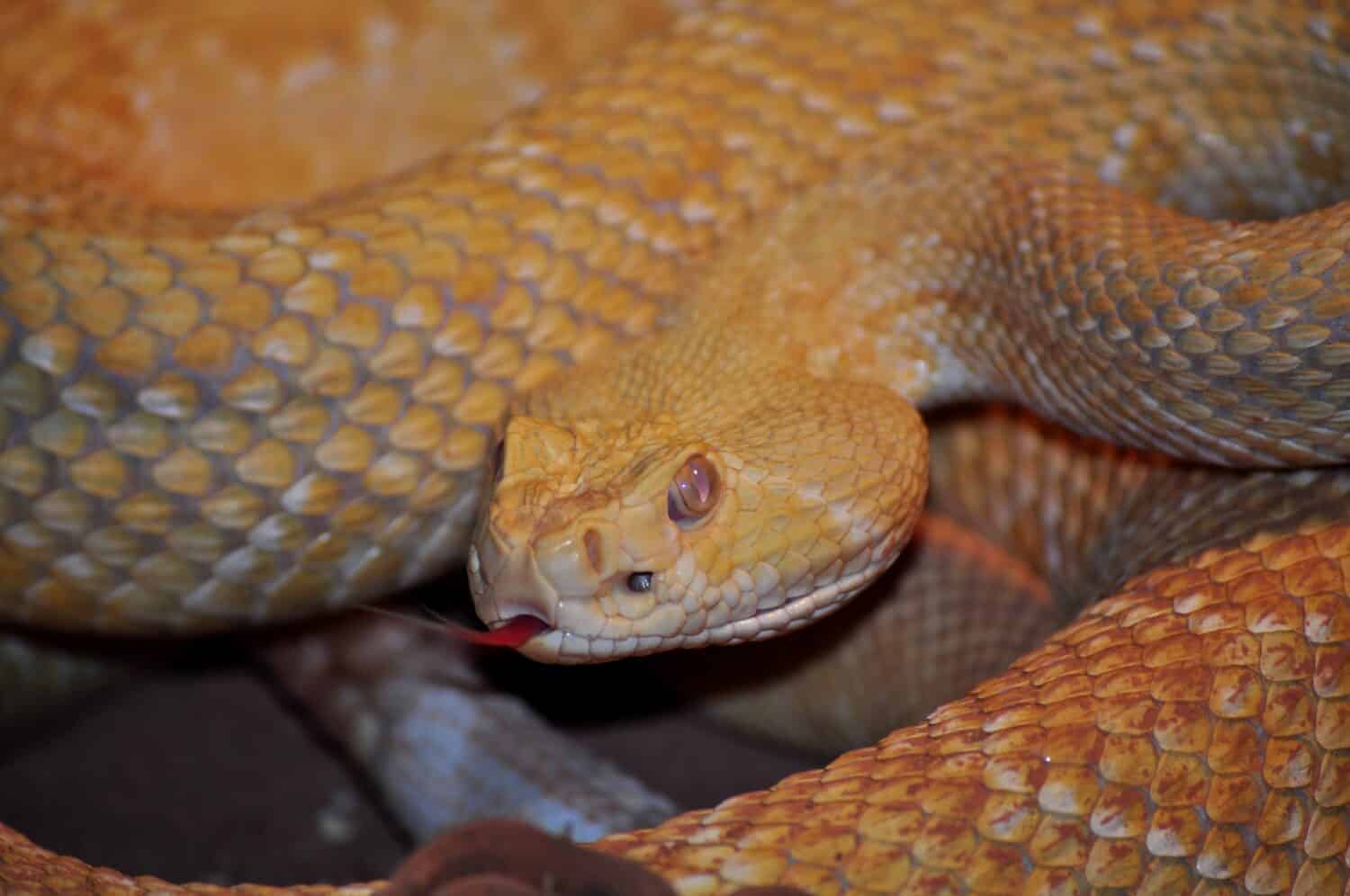
Western diamond-backed rattlesnakes are incredibly dangerous, and if threatened will use their tail rattle to warn off potential predators.
©Zoran zoo-vrt/Shutterstock.com
3. Mojave Rattlesnake
The Mojave rattlesnake is a venomous species found in Arizona. These slithering reptiles are known for their aggressive behavior and dangerous venom. The neurotoxic venom is capable of paralyzing enemies and poses a serious threat to humans.
These snakes are commonly found in the rocky regions of Arizona’s southwestern part. They mainly rely on their camouflage and ambush tactics to surprise unsuspecting prey. Despite their fearsome reputation, Mohave rattlesnakes play a vital role in the ecosystem by controlling populations of small mammals and reptiles.
The Mojave rattlesnake is integral to Arizona’s wildlife, and preserving its place in the natural world is crucial.
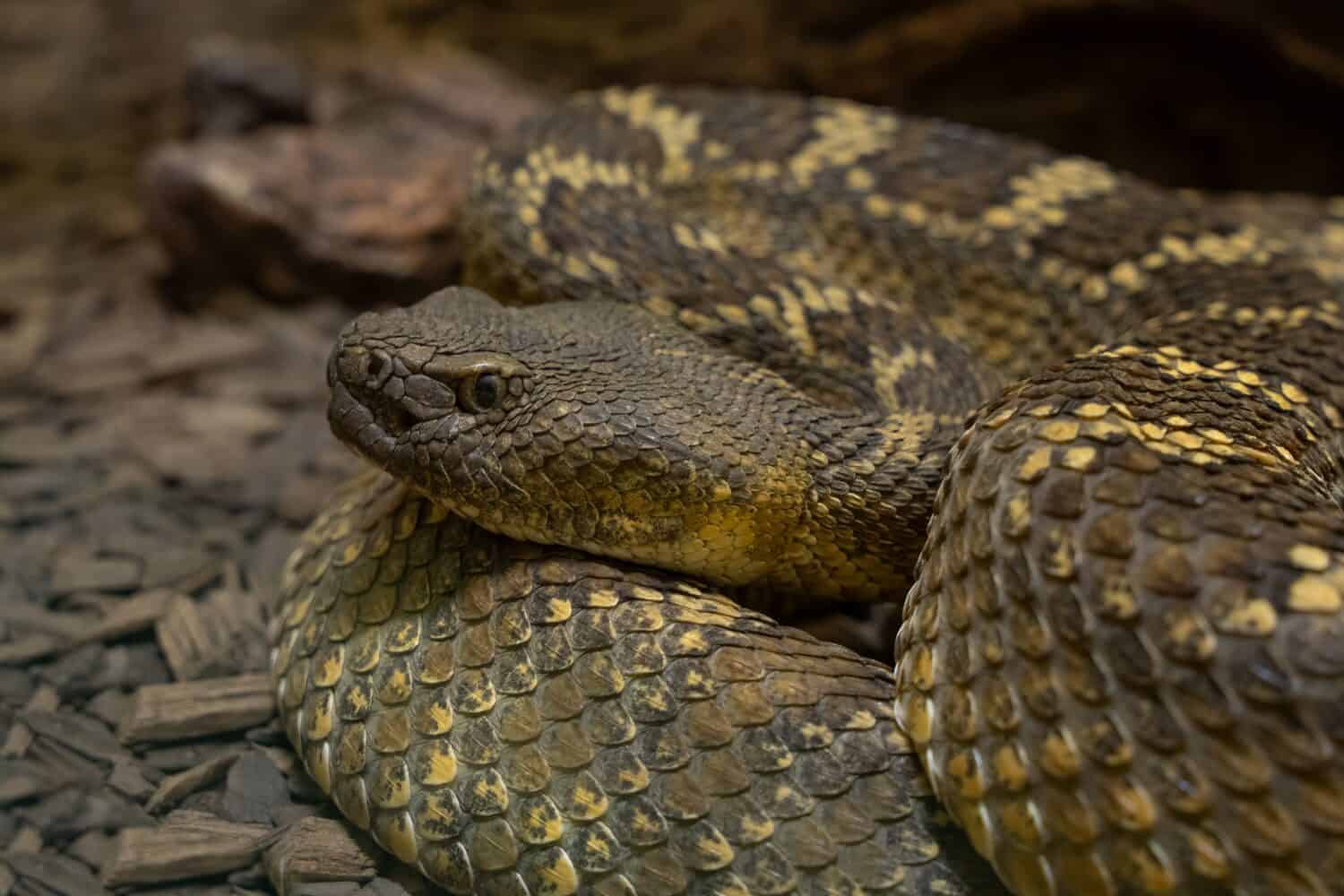
A single bite from a Mojave rattlesnake can be fatal, as it carries a highly potent neurotoxic venom.
©J.A. Dunbar/Shutterstock.com
4. Arizona Black Rattlesnake
The Arizona black rattlesnake, scientifically known as Crotalus cerberus, is a venomous species found in northern Arizona. Distinguished by its striking all-black appearance and the iconic rattle at the tail’s tip used to warn potential predators.
Growing up to 3-4 feet, it thrives in diverse habitats like desert scrublands, rocky canyons, and prairies. Despite its notoriety, this snake is generally shy and only strikes when feeling threatened. Its hemotoxic venom can cause swelling and pain, though human fatalities are uncommon due to its non-aggressive nature.
Conservation efforts focus on preserving these valuable predators and their role in balancing local ecosystems by regulating small mammal and reptile populations.

Although Arizona black rattlesnakes are venomous, they rarely bite unless provoked.
©Thorsten Spoerlein/Shutterstock.com
5. Western Rattlesnake
The western rattlesnake is also known as the Pacific rattlesnake (Crotalus oreganus). It’s a venomous species prominent in Arizona’s rocky southwestern regions. Growing up to 3-4 feet long, their color patterns vary based on habitat.
Preying on small mammals, birds, and reptiles, these snakes are typically shy and prefer retreat over confrontation, yet they will defend when provoked. While their bites can be severe and potentially fatal, readily available anti-venom proves highly effective in managing their venomous bite.
Exercise caution and respect when encountering these fascinating creatures in their natural habitat.

One of the most iconic snakes in North America, the western rattlesnake (
Crotalus oreganus) is a common inhabitant of grassy and rocky areas.
©Audrey Snider-Bell/Shutterstock.com
Snake Population in Georgia
Both venomous and non-venomous snake species can thrive and live in a range of habitats in Georgia. It’s important to be aware of your surroundings whether you’re exploring the countryside or strolling down suburban sidewalks because there are an amazing 46 snake species, including 6 dangerous ones.
While snakes naturally inhabit the southern mountains and Atlantic coastline of Georgia, sightings are not limited to these regions. As Georgia’s population grows, human-snake encounters become increasingly common. Stay vigilant and prepared as we navigate the captivating realm where humans and snakes coexist in the vibrant state of Georgia.
5 Most Venomous Snakes in Georgia
Some of the deadliest snakes in the US can be found in Georgia. Most of these venomous snakes are found in forests and near water bodies. Some can still be spotted on sidewalk pavements, especially in the evening, because the pavements retain the heat for longer.
Here are 5 of the venomous snakes in Georgia:
1. Eastern Diamondback Rattlesnake
The eastern diamondback rattlesnake tops our list of the most venomous snakes in Georgia. It is a majestic and beastly snake with no natural enemies. It’s on the top of the food chain and rules its territory by preying on other reptiles, rodents, and small mammals.
The eastern diamondback rattlesnake is also the largest venomous snake in America. It’s aggressive, always ready to strike, and will attack any animal in sight if threatened. It occupies the southern part of Georgia, although there have been sightings in Middle Georgia.
An adult eastern diamondback rattlesnake averages 4 feet and can reach up to 8 feet in length. Newborns measure about 12-14 inches. Its large size makes it an intimidating predator. Coupled with its potent venom and ability to camouflage in its natural habitat, it’s a nightmare for mice and rabbits.
The snake matures relatively fast and will be ready to procreate after 3 years. The eastern diamondback rattlesnake incubates for 4–6 months and can live up to 20 years — a pretty long lifespan for a dangerous snake.
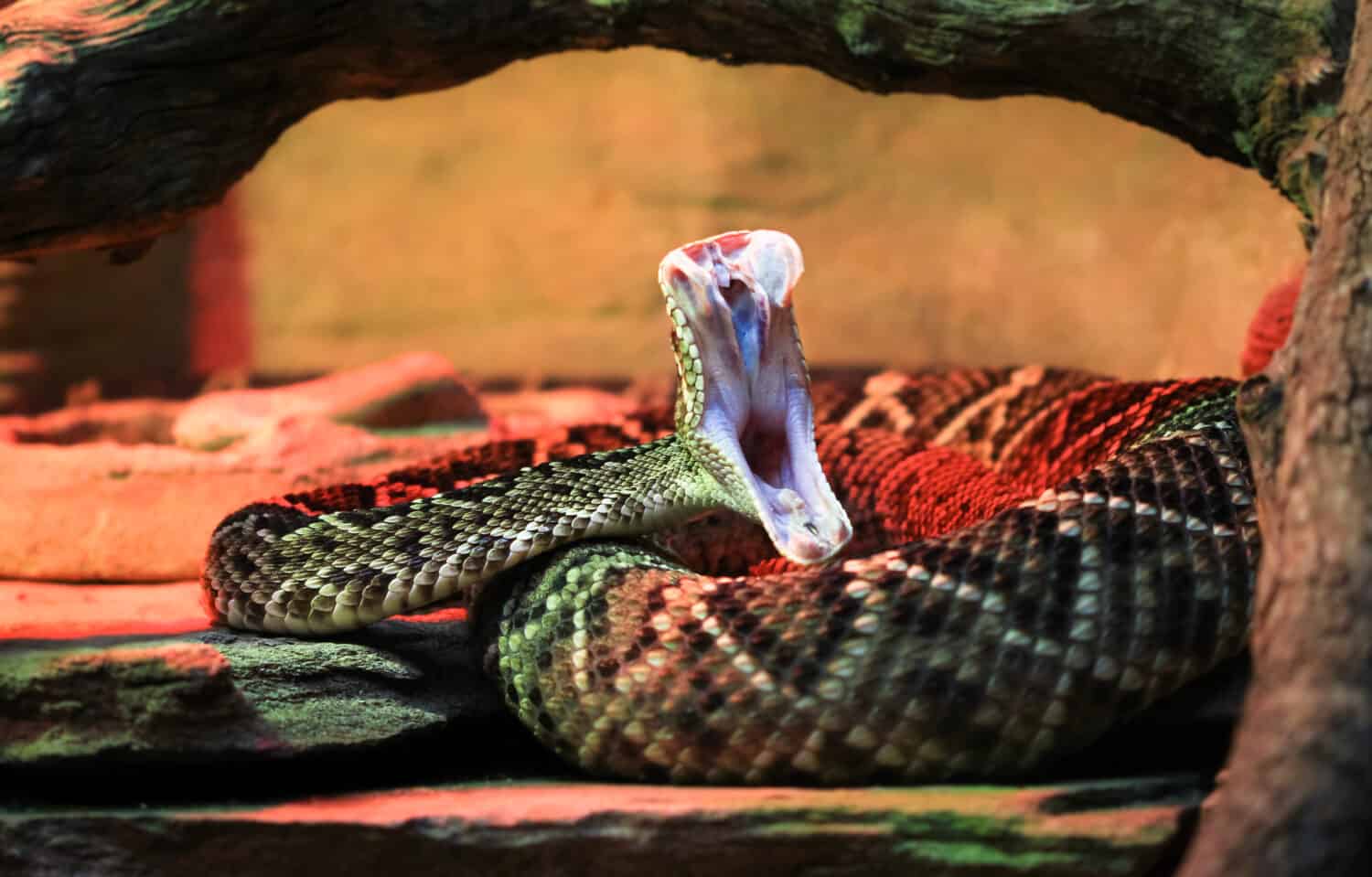
The eastern diamondback rattlesnake is known for its aggressive attitude and powerful venom which can cause serious damage if not treated quickly.
©Kevin Wells Photography/Shutterstock.com
2. Cottonmouth
The cottonmouth viper snake thrives in Georgia’s wet and swampy terrain. It’s an aggressive serpent with hemotoxic venom that liquefies tissue, posing a severe threat to human health. Its bite can cause serious wounds and if unattended, will be fatal. While other venomous snakes are known to retreat even in defense, cottonmouth can pursue its victims even when they begin to flee.
Not only that, but it’s also one of the few semi aquatic snakes in the US. This adaptation makes them especially dangerous because they can attack on land and water.
The cottonmouth snake is known by many names for a reason. It’s been called water moccasin, swamp moccasin, rusty moccasin, or black moccasin. Interestingly, a moccasin is a type of shoe made from leather. It’s called a moccasin because of the pale color of its mouth when it opens its jaws.
It occupies the Southeast and Southern Coastal plains of Georgia and hunts mostly at night when there’s warmth. However, it can come out to bask in the sun during the day.
If you can’t dread this snake for its venom, be scared of its large fangs that lodge the venom deep into the tissues of the prey, incapacitating it.
Though it has a lengthy lifespan of up to 25 years, few of its offspring survive the environment because of its many natural enemies. The newborns are a sumptuous meal for eagles, raccoons, largemouth bass, and snapping turtles, among other predators.
Luckily, adult cottonmouths have fewer natural predators and can multiply faster because the females can reproduce sexually and asexually. If you run into one, walk away slowly without startling it.
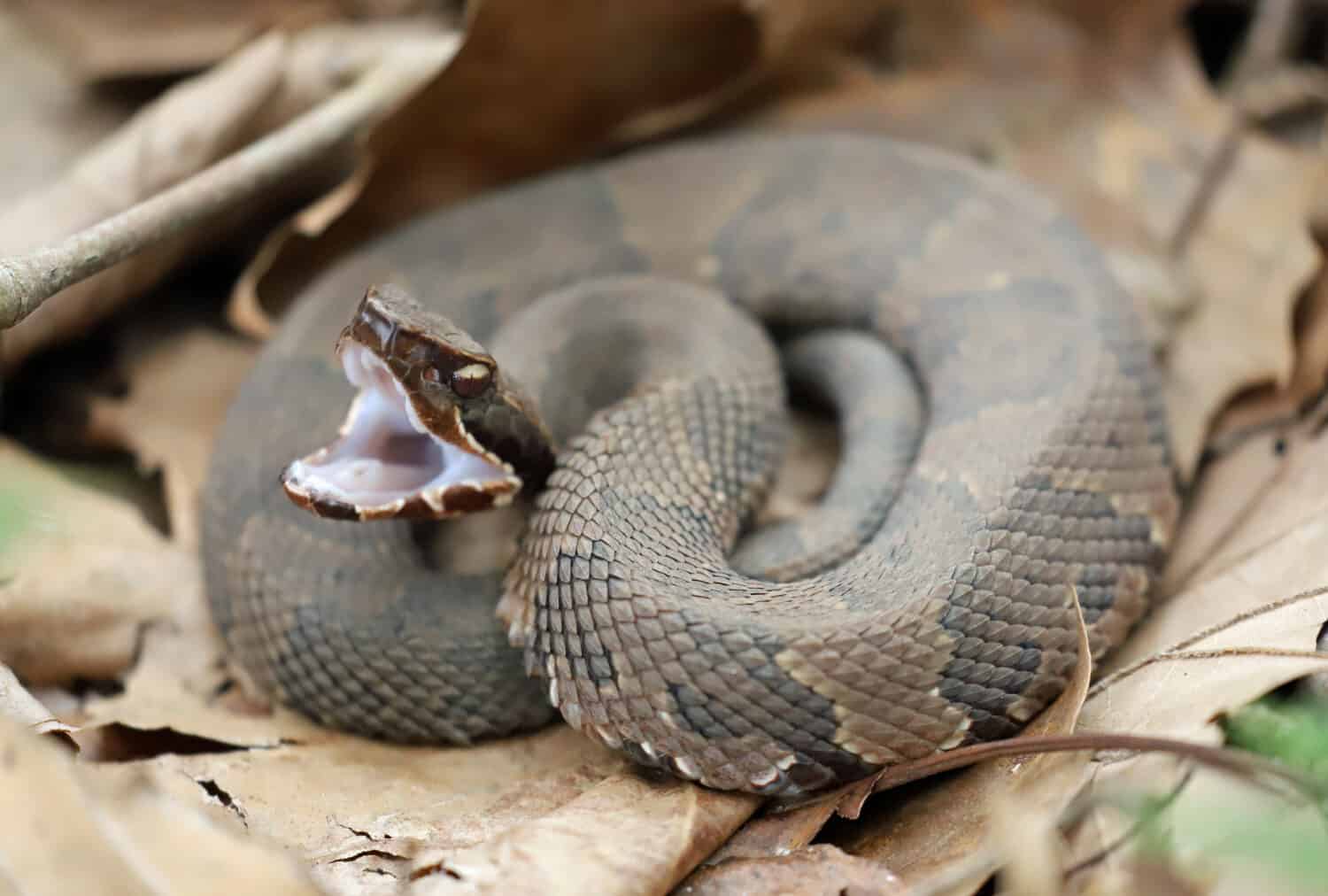
The cottonmouth or
Agkistrodon piscivorusis a venomous snake with a distinctive triangular head and broad bands of black and white.
©KF2017/Shutterstock.com
3. Coral Snake
The coral snake, typically found in southern Georgia, packs a potentially deadly punch with its venom. However, it’s usually docile and slow to strike, accounting for less than 1% of venomous snakebites in the US. Most bites occur when handling the snake. Also, coral snakes can’t strike fast and must hold on briefly to deliver enough venom to harm humans.
There have been zero deaths in the US from coral snake bites thanks to the availability of anti-venom. These stunning serpents are easy to spot with their unique black, red, and yellow banding. They are also relatively short, averaging 2–4 feet.
The coral snake mainly feeds on other snakes, but its diet also incorporates other small mammals like mice. It mainly hunts at night.
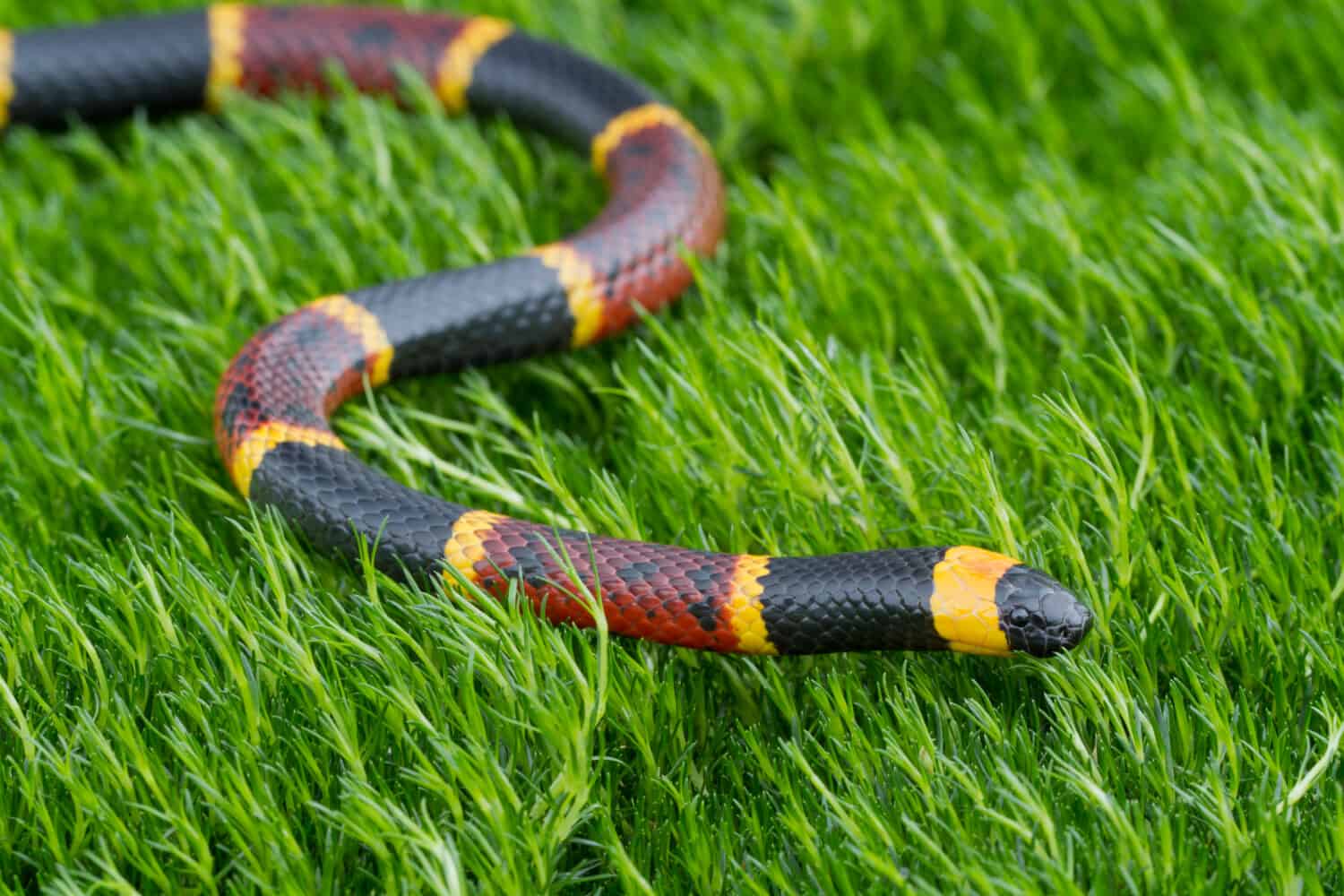
A coral snake’s bright bands of red, yellow, and black serve as a warning to potential predators that this species has powerful neurotoxins in their bite and should be avoided.
©Mark_Kostich/Shutterstock.com
4. Pigmy Rattlesnake
The pigmy rattlesnake is notably smaller than other rattlesnake species. That’s where it gets its name. It’s adorned in gray, tan, or lavender hues, with black spots beautifying the entire body.
These serpents can grow to lengths of 31 inches but are typically observed between 16–23 inches. The pigmy might not be as lethal as other rattlesnakes on this list, but its venom can destroy red blood cells and interfere with blood clotting. The excruciating pain from the bite is enough to stay from the pigmy. The pigmy rattlesnake has a broad palette, feasting on small mammals, birds, lizards, centipedes, frogs, and other snakes.
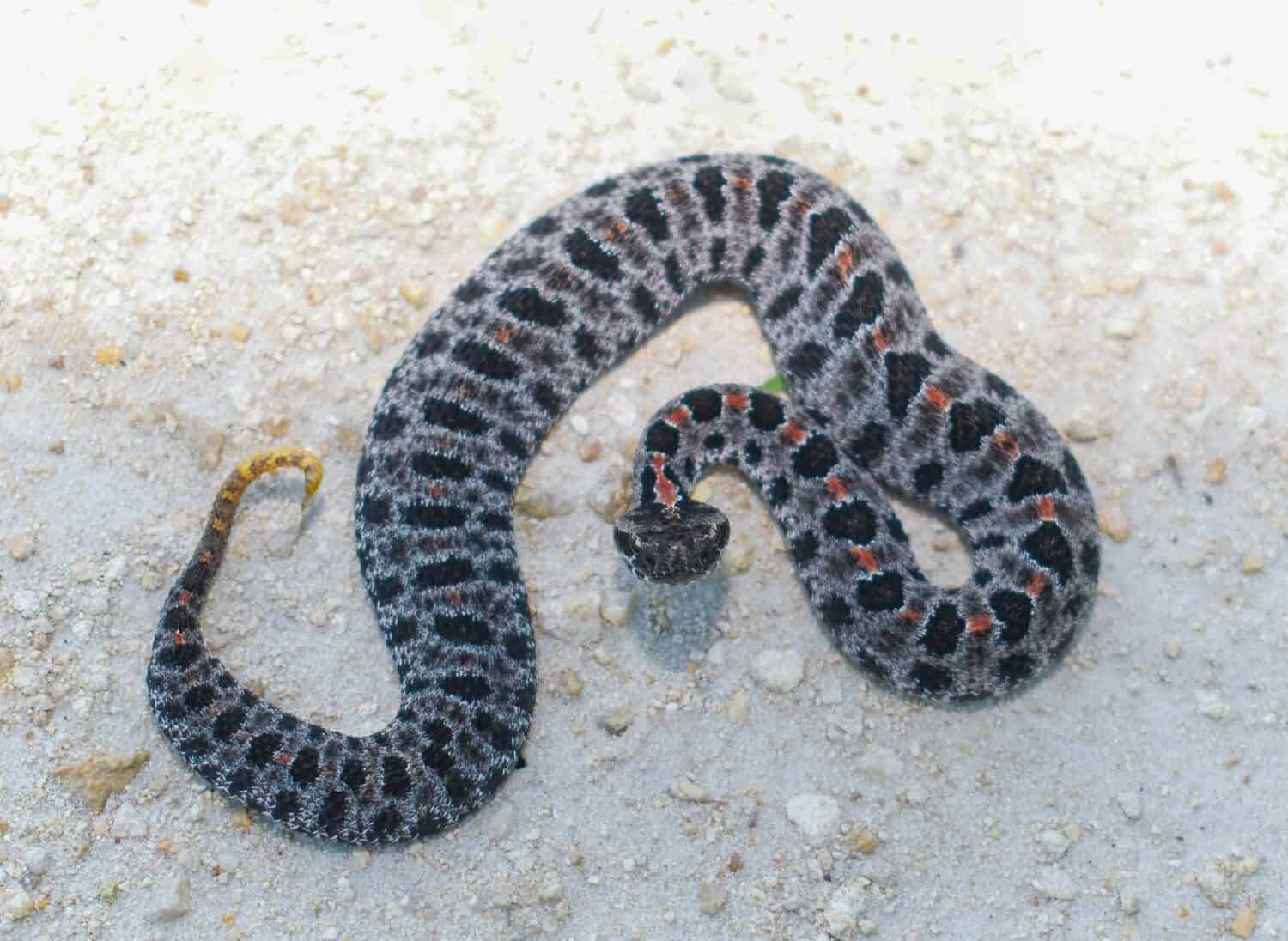
While they can cause serious harm if disturbed or provoked, the pigmy rattlesnake rarely strikes unless it feels threatened.
©Chase D’animulls/Shutterstock.com
5. Copperhead
The copperhead is a viper that inhabits nearly every region of Georgia. It appears in this list because it’s venomous, but its bites rarely cause fatalities among adults. The stinging pain lasts longer, and when bitten, you must find an anti-venom to neutralize it.
Copperheads are responsible for more snake bites annually in the US than any other species. These serpents tend to be most active during the evening and have an aggressive temperament, so it is wise to step away if encountered.
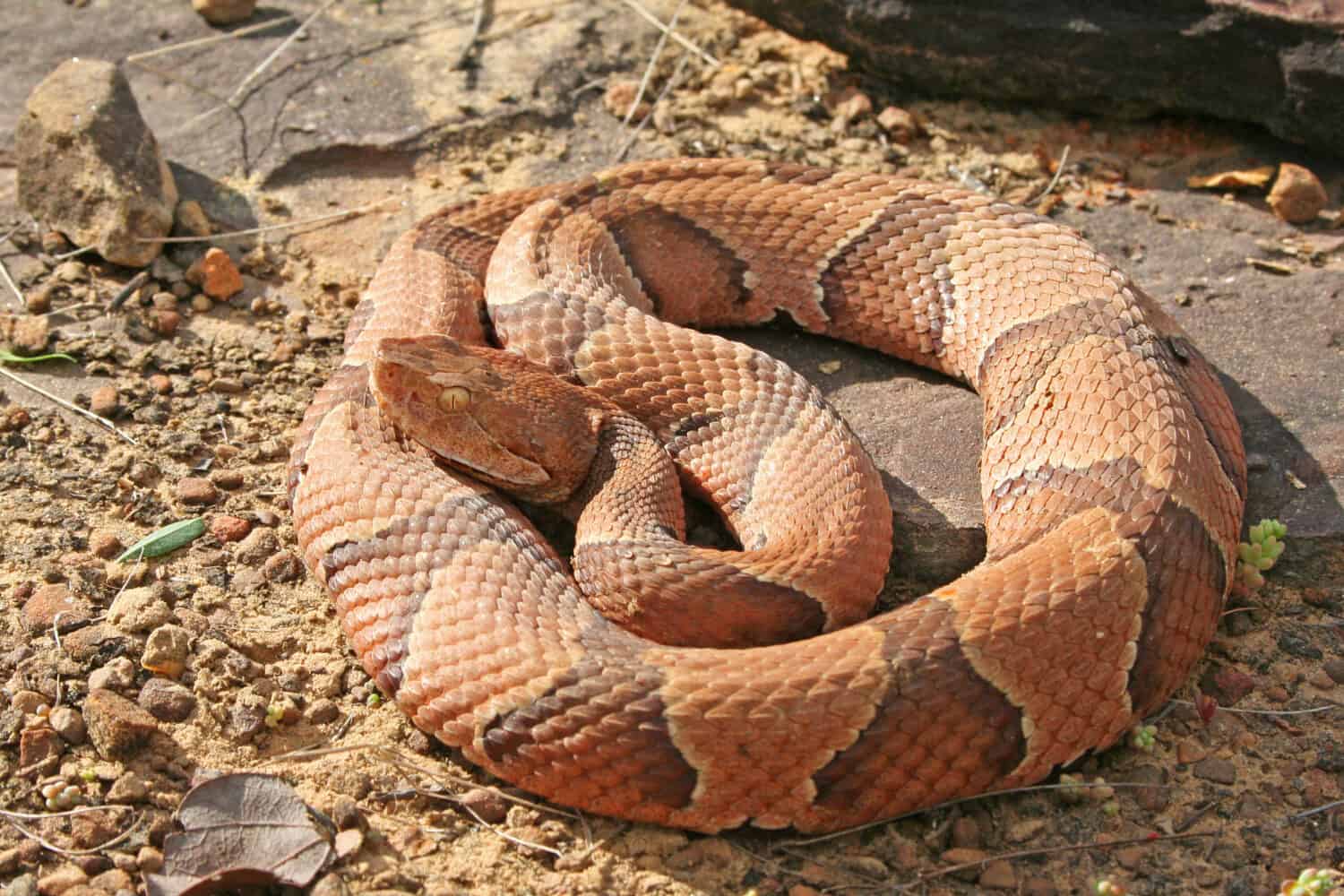
While these snakes are typically shy and non-aggressive when encountered in the wild, it’s important to take safety precautions and keep your distance if you come across one.
©Creeping Things/Shutterstock.com
Comparison: Which State Has More Venomous Snakes?
Arizona and Georgia have many venomous snakes, thanks to their natural geographic features that make excellent habitats for snakes and other reptiles. Arizona has deserts, canyons, and mountains that rattlesnakes love and thrive in.
In the realm of venomous snakes, Arizona reigns supreme, housing the highest concentration in the United States. Prepare for an encounter with a formidable lineup, including the Mojave rattlesnake, western diamondback rattlesnake, Arizona coral snake, Arizona black rattlesnake, and the western rattlesnake.
Conversely, Georgia has a humid climate, dense forests, and a coastline where certain venomous species of snakes find home. While here, beware of the eastern diamondback rattlesnake, cottonmouth, coral snake, pigmy rattlesnake, and copperhead species.
While both states have venomous snakes, the numbers vary widely, with Arizona having up to 23 venomous snakes against Georgia’s 6 venomous species. So we have a clear winner here.
Verdict: Arizona vs. Georgia: Which State Has More Venomous Snakes?
While Arizona and Georgia have over 40 known snake species, the two states differ significantly in the number of venomous snakes. Arizona has up to 23 venomous snakes, while Georgia has only 6 venomous species. Thus, Arizona leads with more venomous snakes.
In conclusion, both Arizona and Georgia boast their share of venomous snakes, adding an element of intrigue and caution to their natural landscapes.
Arizona stands out as a haven for venomous reptiles, hosting a remarkable variety of species, including the infamous rattlesnakes and the enigmatic coral snakes. Georgia, while not as renowned, still presents a diverse habitat for venomous and non-venomous snakes alike.
Whether you explore the rugged terrains of Arizona or venture into the urban and suburban areas of Georgia, it is essential to remain vigilant and educated about the potential encounters with these fascinating yet potentially dangerous creatures.
Remember, respecting the natural habitats and observing proper safety measures ensures a harmonious coexistence with these captivating reptiles in both states.
The photo featured at the top of this post is © Worraket/Shutterstock.com
Discover the "Monster" Snake 5X Bigger than an Anaconda
Every day A-Z Animals sends out some of the most incredible facts in the world from our free newsletter. Want to discover the 10 most beautiful snakes in the world, a "snake island" where you're never more than 3 feet from danger, or a "monster" snake 5X larger than an anaconda? Then sign up right now and you'll start receiving our daily newsletter absolutely free.
Thank you for reading! Have some feedback for us? Contact the AZ Animals editorial team.






